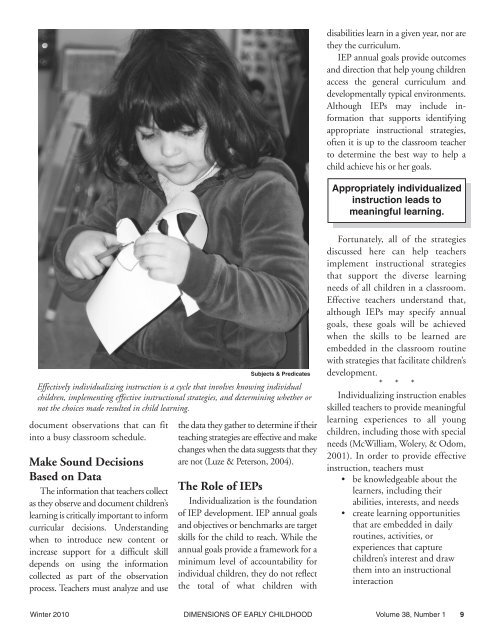90223 Dimensions Winter 10:Layout 1 - Southern Early Childhood ...
90223 Dimensions Winter 10:Layout 1 - Southern Early Childhood ...
90223 Dimensions Winter 10:Layout 1 - Southern Early Childhood ...
Create successful ePaper yourself
Turn your PDF publications into a flip-book with our unique Google optimized e-Paper software.
disabilities learn in a given year, nor are<br />
they the curriculum.<br />
IEP annual goals provide outcomes<br />
and direction that help young children<br />
access the general curriculum and<br />
developmentally typical environments.<br />
Although IEPs may include information<br />
that supports identifying<br />
appropriate instructional strategies,<br />
often it is up to the classroom teacher<br />
to determine the best way to help a<br />
child achieve his or her goals.<br />
Appropriately individualized<br />
instruction leads to<br />
meaningful learning.<br />
document observations that can fit<br />
into a busy classroom schedule.<br />
Make Sound Decisions<br />
Based on Data<br />
The information that teachers collect<br />
as they observe and document children’s<br />
learning is critically important to inform<br />
curricular decisions. Understanding<br />
when to introduce new content or<br />
increase support for a difficult skill<br />
depends on using the information<br />
collected as part of the observation<br />
process. Teachers must analyze and use<br />
Subjects & Predicates<br />
Effectively individualizing instruction is a cycle that involves knowing individual<br />
children, implementing effective instructional strategies, and determining whether or<br />
not the choices made resulted in child learning.<br />
the data they gather to determine if their<br />
teaching strategies are effective and make<br />
changes when the data suggests that they<br />
are not (Luze & Peterson, 2004).<br />
The Role of IEPs<br />
Individualization is the foundation<br />
of IEP development. IEP annual goals<br />
and objectives or benchmarks are target<br />
skills for the child to reach. While the<br />
annual goals provide a framework for a<br />
minimum level of accountability for<br />
individual children, they do not reflect<br />
the total of what children with<br />
Fortunately, all of the strategies<br />
discussed here can help teachers<br />
implement instructional strategies<br />
that support the diverse learning<br />
needs of all children in a classroom.<br />
Effective teachers understand that,<br />
although IEPs may specify annual<br />
goals, these goals will be achieved<br />
when the skills to be learned are<br />
embedded in the classroom routine<br />
with strategies that facilitate children’s<br />
development.<br />
* * *<br />
Individualizing instruction enables<br />
skilled teachers to provide meaningful<br />
learning experiences to all young<br />
children, including those with special<br />
needs (McWilliam, Wolery, & Odom,<br />
2001). In order to provide effective<br />
instruction, teachers must<br />
• be knowledgeable about the<br />
learners, including their<br />
abilities, interests, and needs<br />
• create learning opportunities<br />
that are embedded in daily<br />
routines, activities, or<br />
experiences that capture<br />
children’s interest and draw<br />
them into an instructional<br />
interaction<br />
<strong>Winter</strong> 20<strong>10</strong> DIMENSIONS OF EARLY CHILDHOOD Volume 38, Number 1 9
















